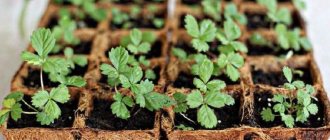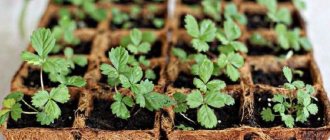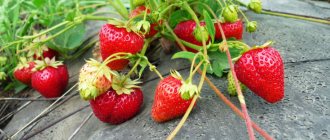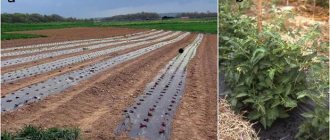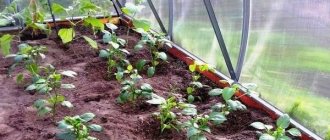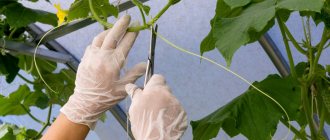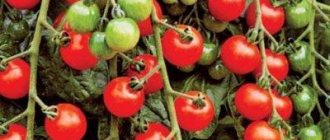If you are just going to plant strawberries or can’t achieve a good harvest, or are looking for the ideal variety, or just want to know everything about growing this crop, read the material from experienced breeder Mikhail Kachalkin.
He comprehensively answered all the questions that arise for both beginners and experienced gardeners in the process of selecting, planting and caring for garden strawberries. He also shared his secrets and proven varieties.
Mikhail Kachalkin – Candidate of Agricultural Sciences, breeder, director of the Experimental Breeding Nursery LLC.
How to choose the size of a strawberry bed
At your discretion. But practice shows that a width of 90 cm is convenient for all work on caring for strawberries. How many bushes do you need? If you just eat, then 15-20 plants are enough for a family of three. For each plant, allocate approximately 0.5 sq.m. in the garden bed.
And if there are a lot of berry lovers, and even preparations are planned, then you probably need 50-60 plants. Focus on a yield of 0.5 kg per bush. Moreover, using the earliest and latest varieties, you can stretch the supply of fresh berries for 30-40 days, from the end of June to the beginning of August. And in the case of remontant varieties - from early June to mid-October. But keep in mind that a planting pattern of 50x50 cm is too small, 60x60 cm is better, so that there is good lighting and ventilation on all sides.
The best strawberry varieties for planting in open ground
There are many varieties of this fragrant berry, and each has its own advantages. So, most gardeners are inclined to grow remontant strawberries. These varieties can produce berries until autumn. In addition, their harvest is much more abundant than other varieties.
Abundant strawberry harvest
The best varieties of remontant type:
- "Mara de Bois". The variety is suitable for areas with cool climates. It produces juicy and beautiful berries, and the seedlings tolerate transportation well. When transplanted, 95% of the bushes take root, which is considered a very good indicator.
- "Temptation". The berries of this variety have an unusual taste with nutmeg notes. You can achieve a yield of 3 kg of strawberries from one bush. The berries grow on bushes and tendrils and can be picked from mid-May to the end of September.
- "Albion". Suitable for southern regions. The bushes are equipped with large leaves that can hide the berries from the scorching sun. The first harvest ripens in the last ten days of May. The berries are very sweet and beautiful.
- "Elizabeth 2". Russian breeders created this variety specifically for areas with constant cold. The bushes produce sweet berries that are equally good for canning, freezing and fresh. Fruiting begins in early June and ends at the end of September.
Strawberry variety Temptation
Strawberry varieties with early ripening:
- "Elsanta". The variety comes from Holland, which produces sweet berries with a slight sourness. Strawberries ripen quickly and are ideal for canning, but are not suitable for long-distance transportation.
- "Kama". Extraordinarily aromatic berries, yield reaches 3 kg per bush. However, the variety is very demanding. Each bush must be mulched with dry grass, otherwise the berries will rot due to contact with the ground. They are located very low and covered with leaves.
Strawberry variety Kama
- "Zephyr." Danish variety with a rich harvest and a large number of peduncles. The bushes are immune to diseases, but before winter they need insulation in the form of a cap of dry straw or cut branches.
- "Honey." An excellent variety with strong rhizomes and intensive growth. It has large berries with an extraordinary aroma. The harvest can be harvested from mid-May to the end of June. The bushes produce a lot of tendrils, which are cut off and dug in.
- "Gigantella". Produces berries up to 5 cm in diameter with dense juicy pulp. The bushes have large leaves, so they need to be planted away from each other. It has a high content of useful substances.
- "Festival" A variety with bright juicy berries that melt in your mouth. You can harvest up to 3 kg of strawberries from one bush. Requires special care.
Strawberry variety Zephyr
Strawberries with large fruits:
Festival strawberries
You can read more about growing remontant strawberries in our article.
Prices for strawberry seeds
strawberry seeds
What fertilizers do strawberries need, and is it possible to do without them?
Strawberries do not like a lot of fertilizers, but they also cannot be grown without them. Or rather, it is possible, but you will need a lot of manure humus, compost or vermicompost. Moreover, it should be taken into account that many nutrient soils that are sold in garden centers contain mineral fertilizers.
So, “mineral water”, preferably imported chlorine-free water, for example, New Universal in a dose of 50-70 g per 1 sq.m. We dig everything well, select the weeds, mix the mineral water and compost with peat and form a bed 20-25 cm high. We plant the seedlings in a week or two, or preferably three, after the earth has settled a little.
On a straw bed
Prepare a strong solution of potassium permanganate and pour it over the strawberry beds: bushes and the ground around them.
After a week, feed with soaked chicken manure in a ratio of 1:10. And then, after three days, dig everything up thoroughly. Cover the row spaces with straw. This frees up time to pursue other cultures.
Bush with straw bedding
- strawberries covered with straw do not become overgrown with weeds,
- it needs less watering,
- the berries grow and ripen clean,
- plants get sick less
Raised on a straw bed
Why do many people cover their garden beds with black film?
Variety Evis Delight
We advise you to purchase a film or non-woven material of black color, with a density of 80 g/sq.m. When growing strawberries, it allows you to solve several problems at once. First of all, it is protection from weeds, which with regular watering are a real disaster. Secondly, the soil under the shelter will dry out less and warm up better, and this is very good for plants.
And finally, the berries will lie on clean material, which means they will rot less. In addition, the tendrils that form at the beginning of flowering will not be able to take root on the black tissue, and you will not have to tear them out of the ground - you will simply cut them off several times during the season: if they are not removed, they will “eat” up to 30% of the harvest.
If you want to breed a certain variety, then young rosettes can be rooted in pots, and then separated from the mother plant and grown in a greenhouse. Just keep in mind that plants in pots require daily watering.
Preparation of seedlings
If you decide to grow strawberries indoors, first of all, you need to take care of the seedlings.
- Seedlings can be purchased at a nursery or specialty store, but it is better to prepare seedlings yourself.
- To do this, you can take cuttings of tested varieties that you have already grown before.
- During the summer, root the young plants and, after the formation of the root system is completed, transplant them into a container with loose soil. Do not allow the soil in the nursery to dry out.
- When temperatures drop, move the nursery to a greenhouse. Young plants can be rooted in small disposable pots with a diameter of 9 cm.
- You can dig up young plants in the fall, cut off the leaves, place them in the refrigerator and store them in a plastic bag until spring.
Caring for garden strawberries after planting
First of all, high-quality regular watering is necessary. Shading promotes survival of bushes very well. This can be old non-woven material or simply tufts of grass or hay placed on top of planted plants for 3-4 days. They will protect the seedlings from the sun and wind. If it is the beginning of May, then you can simply throw non-woven material on top of the bushes.
If you plant seedlings in mid-May or later, then a frame is already needed (as for cucumbers), because Plants may burn under non-woven material. In this form (under the frame) they can be kept until the beginning of June, watering and opening at least once a week. It is very useful to pick off the first flowers, then the plants will be well formed and will subsequently give you a bountiful harvest. Before flowering, remove the cover, because flowers must be accessible to bees.
Spring breeding
It is recommended to renew strawberry beds every 3 years, and in order not to be left completely without berries, the plants are replanted gradually - in a small area every year. The planting site must be changed periodically, given that viral diseases of nightshades, peppers, cabbage, and cucumbers are transmitted to berry crops. Planting strawberries in the spring has a positive property - the bushes will have time to take root firmly before the onset of cold weather, which will allow them to overwinter more easily. When choosing a suitable variety, pay attention to disease resistance and the size of the berries, which will still become smaller over time.
When planting, make sure that the roots of each bush are well straightened and positioned in such a way that the core is not covered with soil, otherwise the plant will die, and if placed superficially, the roots are exposed, which will lead to drying out and poor development of the plant.
A high-quality strawberry harvest can only be obtained on an irrigated plot. Soil moisture is determined by touch by digging a hole with a shovel to the depth of the roots. Watering is done in different ways:
- A watering can is only relevant for a small garden bed.
- From a hose - a minimum of physical effort, but there is a danger of uneven distribution of water and damage to young plantings.
- The drip method has a huge advantage - the necessary fertilizers can be supplied along with water.
- Circular, fan, rotary or other sprinkling method.
- Along the furrows, having previously prepared special grooves, seedlings are planted into the walls.
Before planting young seedlings, it is necessary to find out the acidity of the soil, the optimal indicator for strawberries is 5-7 pH, as well as the level of groundwater (more than 60 cm is needed), the presence of Colorado potato beetle larvae, wireworms, nematodes, which should be mercilessly destroyed with special preparations.
For better survival, before planting, plant roots are immersed in a clay mash: half a bucket of ordinary clay is diluted with water to the consistency of liquid sour cream. To make the mass homogeneous, knead all the lumps with your hands.
In small areas, strawberries are planted using a cord: marks are placed on opposite ends of the bed, pegs are secured, and a strong rope is pulled. A small stick (25 cm) marks the places for the holes, which are dug with a shovel or a special ripper. Pour in one liter of warm water, place a seedling in the resulting earthen slurry, carefully covering the roots with mud. Then they are covered with ordinary soil and pressed tightly.
Caring for remontant strawberries
If you planted remontant strawberries, you will have berries almost until the end of October. Therefore, in mid-August, you can again build a shelter from non-woven material, but with good end ventilation.
In addition, keep in mind that remontant strawberries are more demanding in terms of watering and fertilizing. During the season, it is enough to feed the strawberries twice: once in the spring, in early May, and then after harvesting. A complex mineral fertilizer such as Kemira Universal is suitable. If you are against mineral fertilizers, use an infusion of chicken droppings or manure, just do not overdo the concentration.
Selection of seedlings
If you want to get a rich harvest, then purchase elite varieties, preferably the first reproduction.
- The seedlings must be healthy, calibrated, with good roots.
- The most successful place for planting strawberries is considered to be southern and southwestern slopes with a slope of 2 degrees.
- In such areas, berries usually ripen 2 weeks earlier. It is not recommended to grow strawberries. In lowlands, ravines, gullies.
Planting material prepared for planting
- The ideal acidity of the soil solution is considered to be 5.5 - 6.0.
- Seedlings can be planted in open ground, both in spring and autumn.
- If you decide to plant seedlings in the spring, then do it as early as possible, as soon as weather conditions permit.
High-quality seedlings – good harvest
- Before planting in the ground, it is advisable to harden the seedlings and accustom them to open ground conditions.
- When planting, do not bury the neck of the bush; it should be flush with the ground.
- The roots should be placed vertically in the hole.
- If the roots are too long, they can be trimmed. This technique stimulates the formation of additional lateral roots.
Planted seedlings
Wintering garden strawberries
In normal standard winters, strawberries overwinter well, including foreign varieties. But sometimes, when there is no snow for a long time in November-December and frosts down to –15-20°C, it can freeze, so be prepared to cover the plants with straw, sawdust, and non-woven material. But keep in mind that this cannot be done in advance: it may turn out that deep snow will fall on the wet soil and there will be above-zero temperatures under the shelter all winter, then the plants may be supported. If the ground is frozen and severe frosts are predicted, then you need to go to the dacha and cover the strawberries.
The simplest and most effective solution is non-woven material. In the spring, after the snow melts, it is immediately removed and the strawberry foliage crushed from the snow is loosened. In addition, it is very useful to spray old leaves with some copper-containing preparation (copper sulfate, copper oxychloride, HOM, Abiga-Pik fungicides) in the concentrations recommended for treatment of green foliage. Or simply dust the leaves with dry wood ash at the rate of 20 g per plant.
In some years, when the snow is deep, the soil beneath it thaws early, and conditions for basking plants again arise. Therefore, if this happens, do not be lazy at the end of winter to dig out the bed and leave only a small layer of snow.
Should strawberry beds be dug up?
Each gardener decides for himself whether he should dig up his strawberry beds, but the information offered below will make this process more reasonable. When digging both in the fall and in the spring, we actually loosen the soil, make it receptive to light and air, but at the same time we destroy the fibrous roots.
This happens despite all precautions, because these roots are thin, like a spider's web, and spread far across the soil in the form of a network, which we tear apart every time we stick a shovel.
After digging, the plants begin to slowly form new lobes, slowly in the fall, more quickly in the spring, but those who have observed correctly have long known that strawberry plants have already prepared the next year’s harvest in September. If we dig up at this time or a little later, in the fall, we will make the plants, due to the destruction of the roots, more resistant to frost.
If we dig in the spring, then although the planting will not suffer from frost, often very strong spring winds can have a very harmful effect on it. Therefore, you should do this: as soon as new growth begins and the condition of the soil allows it, hoe shallowly, but as often as possible and when there are no weeds, therefore much more often than other plants.
In this way, a permanent, although very shallow, but loose layer will be achieved, allowing air and light to the roots and reducing the evaporation of much-needed moisture.
